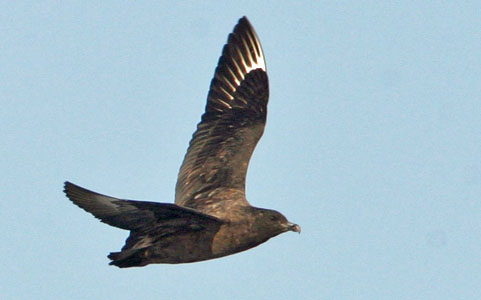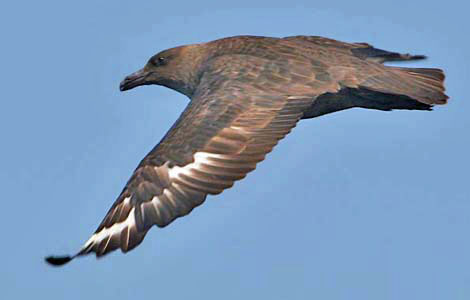| |
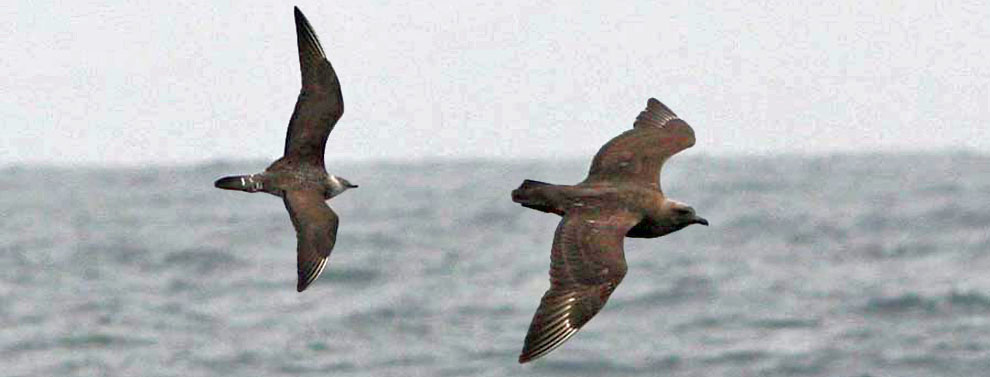 |
SKUAS & JAEGERS Stercorariidae |
- 7 species worldwide
- DR personal total: 7 species (100%), 7 photo'd
|
 The Skuas are a distinctive group of larid-like predators. Kleptoparasitism or piracy — the stealing of food from other birds — is highly developed in this family. British observers call all seven species "skuas," while Americans restrict the term "skua" to four species of very closely related 'Catharacta' skuas, leaving the three Holarctic breeding species — the original Stercorarius group — as "jaegers." In the photo above, a Long-tailed Jaeger is chasing a South Polar Skua over Monterey Bay. The Skuas are a distinctive group of larid-like predators. Kleptoparasitism or piracy — the stealing of food from other birds — is highly developed in this family. British observers call all seven species "skuas," while Americans restrict the term "skua" to four species of very closely related 'Catharacta' skuas, leaving the three Holarctic breeding species — the original Stercorarius group — as "jaegers." In the photo above, a Long-tailed Jaeger is chasing a South Polar Skua over Monterey Bay.
A light-morph adult Pomarine Jaeger, with its characteristic tail "spoons," is shown here on migration (left). In the Old World, this same species is known as Pomarine Skua [or if you are "old school," Pomatorhine Skua; Witherby 1944]. Molecular evidence shows that Pomarine Jaeger is more closely related to the larger skuas than it is to the two smaller jaegers (e.g., Cohen et al. 1997); they suggested that genus Catharacta be merged into Stercorarius, a suggestion adopted by A.O.U. (2002). Yet it is easy and convenient to separate the seven species of Stercorarius into 4 skuas and 3 jaegers. I live on the shores of Monterey Bay and take pelagic trips regularly. The three jaegers are regular migrants and are routine (in season), but the shout "SKUA!" means an encounter with something much rarer — South Polar Skua — that deserves immediate attention! Its numbers here are minuscule compared to the three jaegers. Here, at least, the difference between "jaeger" and "skua" is important.
|
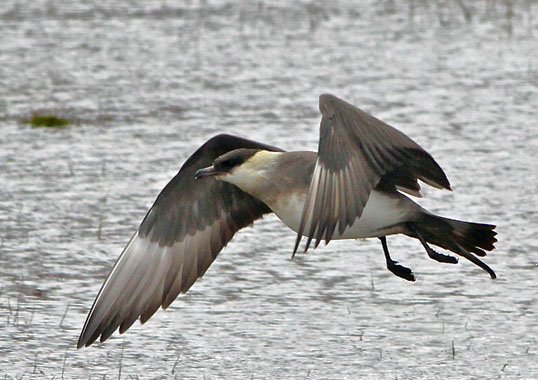 The three jaegers nest on the Holarctic tundra and migrate over the sea to warmer equatorial and southern oceans for the Holarctic winter. Parasitic Jaeger nests on small tundra ponds, like this adult on Svalbard, north of Norway (left) [where Old World English-speakers call it Arctic Skua]. All skuas/jaegers show adaptations associated with their piratical and predatory way of life, and with their breeding at high latitudes close to both poles. The plumage is particularly dense to limit heat loss, and the heavily armored legs and feet are thought to serve a similar purpose. Strong bills and claws aid the predatory lifestyle, as to short wings and powerful musculature for piracy (Furness 1996). The three jaegers nest on the Holarctic tundra and migrate over the sea to warmer equatorial and southern oceans for the Holarctic winter. Parasitic Jaeger nests on small tundra ponds, like this adult on Svalbard, north of Norway (left) [where Old World English-speakers call it Arctic Skua]. All skuas/jaegers show adaptations associated with their piratical and predatory way of life, and with their breeding at high latitudes close to both poles. The plumage is particularly dense to limit heat loss, and the heavily armored legs and feet are thought to serve a similar purpose. Strong bills and claws aid the predatory lifestyle, as to short wings and powerful musculature for piracy (Furness 1996).
Jaegers come in color morphs, perhaps more prevalent in Parasitic Jaeger than other species. Here in Monterey Bay, light-morph Parasitic Jaegers are typical (below left), but dark-morph examples do occur (below right). |
|
| While any particular jaeger or skua may chase most any bird that has food, here on Monterey Bay the migrations of the three jaegers are closely tied with the migrations of three smaller seabirds (at your site, your kleptoparasitic victims may vary). Here, the large Pomarine Jaeger is generally found in a band ~2-20 miles offshore where the migration of Sabine's Gull Xema sabini occurs, or at least this pattern is apparent in August-September. Some Pomarine Jaegers linger around Monterey Bay into late fall and winter, and switch their piratic efforts to Black-legged Kittiwakes Rissa tridactyla and California Gulls Larus californicus. The mid-sized Parasitic Jaeger is most often encountered within a mile or two of shore, and sometimes in estuaries, as it chases Elegant Terns Sterna elegans that have moved north from nesting grounds in Mexico or southern California. The small and lovely Long-tailed Jaeger (below) kleptoparastizes the dainty Arctic Terns Sterna arctica that head south far offshore. Thus Long-tailed Jaeger is usually found 20-40 miles offshore on longer pelagic trips, and is less often seen from shore than the other species.. |
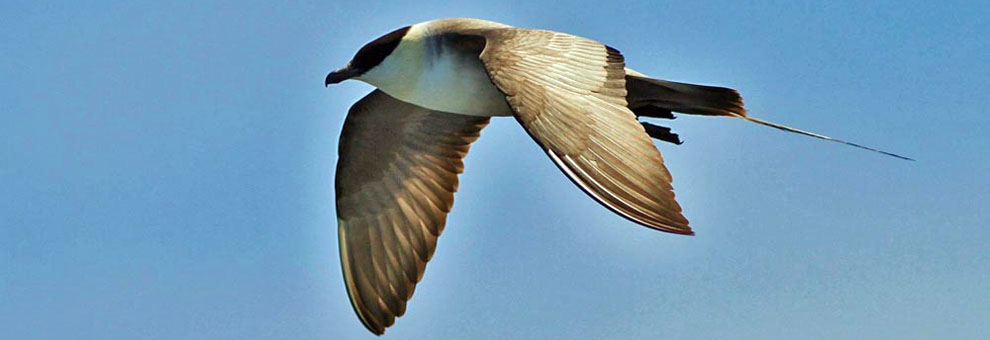 |
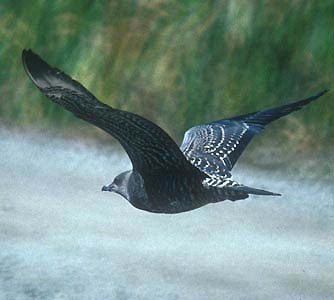 All the photos so far have been of adults with characteristic tail patterns. Jaegers typically do not breed until 3 years old, and the larger skuas not until they are 5-6 years of age (Furness 1996, Olsen & Larsson 1997). Immature plumages are complex and the transitional forms in sub-adults are not well understood. Yet we do now have a good handle on the identification of juvenal-plumaged jaegers in their first flight south. The "cold-colored," short-billed juvenal jaeger in flight (right) is Long-tailed Jaeger. And yes, that is something different that the ocean in the background! This juvenal Long-tailed strayed inland to the Salinas wastewater ponds in September 1990. All the photos so far have been of adults with characteristic tail patterns. Jaegers typically do not breed until 3 years old, and the larger skuas not until they are 5-6 years of age (Furness 1996, Olsen & Larsson 1997). Immature plumages are complex and the transitional forms in sub-adults are not well understood. Yet we do now have a good handle on the identification of juvenal-plumaged jaegers in their first flight south. The "cold-colored," short-billed juvenal jaeger in flight (right) is Long-tailed Jaeger. And yes, that is something different that the ocean in the background! This juvenal Long-tailed strayed inland to the Salinas wastewater ponds in September 1990.
Skuas are closely related to gulls, terns, skimmers, and alcids; indeed, some time ago, Sibley & Monroe (1990) considered them simply a tribe (not even a subfamily) of an expanded Laridae family. Skuas as a Family-level group now seems firmly established, both in traditional sources (e.g., Furness 1996) but in current taxonomy. Recent genetic research suggest that Stercorariidae is sister to Alcidae, rather than gulls {Laridae], as had previously been the conventional wisdom (Fain & Houde 2007, Pereira & Baker 2010).
|
 |
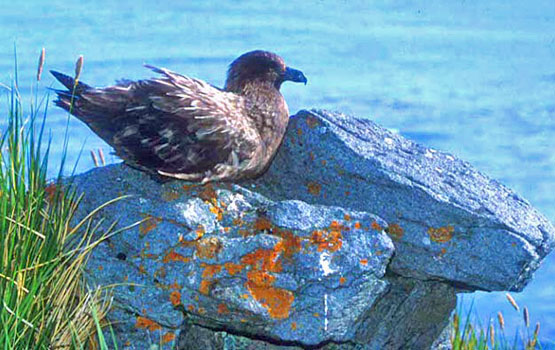 The four species that Americans call skuas — the traditional 'Catharactca' species — are quite similar to each other, although one breeds in the high arctic [Great Skua, shown above in flight across the snow-bound, treeless island of Svalbard] and the other three breed on and around the South Polar ice-cap and sub-antarctic islands [e.g., Brown Skua, on territory on South Georgia Island in a nice shot by Greg Lasley, left). The four species that Americans call skuas — the traditional 'Catharactca' species — are quite similar to each other, although one breeds in the high arctic [Great Skua, shown above in flight across the snow-bound, treeless island of Svalbard] and the other three breed on and around the South Polar ice-cap and sub-antarctic islands [e.g., Brown Skua, on territory on South Georgia Island in a nice shot by Greg Lasley, left).
Kleptoparasitism is highly developed in skuas, but on the breeding grounds they are often predators on young or eggs. Some species or populations take almost all their food at sea by stealing from other birds. The three southern species nest around colonies of other seabirds, and are major predators and scavengers on penguins, terns, gulls, and baby seals and sea-lions. The big white wing patches in the outer primaries may serve to emphasize to other birds that a pirate is attacking, and that they best disgorge their prey! |
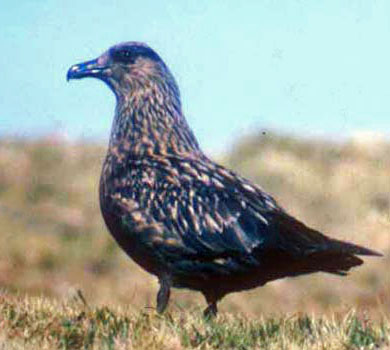 All the big brown skuas have prominent white patches at the base of the primaries. As noted, the big brown skua in northern Europe is Great Skua (right, a photo by John Marchant from Shetland), for which the Brits use the slang "bonxie." Great Skua, and the three similar species breeding around Antarctica, present an identification challenge; see Devillers (1977, 1978), Olsen & Larsson (1997). All four species of big brown skuas wander widely, although Brown Skua generally stays in southern oceans. Great Skua moves widely in the North Atlantic. Chilean Skua Stercorarius chilensis, often identifiable by the rusty-orange tones to the plumage (especially on the underwing coverts), moves up both coasts of South America, but does not wander to the northern Hemisphere (as far as we know). South Polar Skua is a trans-equatorial migrant in both the Atlantic and Pacific, with records as far north as the Gulf of Alaska. All the big brown skuas have prominent white patches at the base of the primaries. As noted, the big brown skua in northern Europe is Great Skua (right, a photo by John Marchant from Shetland), for which the Brits use the slang "bonxie." Great Skua, and the three similar species breeding around Antarctica, present an identification challenge; see Devillers (1977, 1978), Olsen & Larsson (1997). All four species of big brown skuas wander widely, although Brown Skua generally stays in southern oceans. Great Skua moves widely in the North Atlantic. Chilean Skua Stercorarius chilensis, often identifiable by the rusty-orange tones to the plumage (especially on the underwing coverts), moves up both coasts of South America, but does not wander to the northern Hemisphere (as far as we know). South Polar Skua is a trans-equatorial migrant in both the Atlantic and Pacific, with records as far north as the Gulf of Alaska.
Below, a Brown Skua off Cape Town, South Africa (left), and a South Polar Skua over Monterey Bay (right), show off white wing patches in flight. Curiously, off the west coast of Mexico and California, a small percentage of the small, dark Heermann's Gull Larus heermanni have developed white wing patches at the base of the primaries, presumably as a mimic. The maneuverable Heermann's often "pirate" food from slower, less agile gulls. I've seen a Heermann's chasing even a South Polar Skua on Monterey Bay — an example that "turnabout-is-fair-play." |
|
| |
Photos: The subadult Long-tailed Jaeger Stercorarius longicaudus chasing a South Polar Skua S. maccormicki was offshore over the Monterey Seavalley, California, USA, on 16 Aug 2009. The adult Pomarine Jaeger S. pomarinus was on Monterey Bay, California, on 5 Sep 2021. The adult Parasitic Jaeger S. parasiticus was on the breeding grounds at Longyearben, Svalbard, Norway, on 25 June 2013. Both the light-morph and dark morph Parasitic Jaegers S. parasiticus were migrants on Monterey Bay, just west of Moss Landing, on 12 Sep 2015. The adult Long-tailed Jaeger S. longicaudus was well offshore on Monterey Bay on 24 Aug 2013; the juvenal-plumaged Long-tailed Jaeger was a vagrant inland at the Salinas wastewater ponds, Monterey Co., California, on 2 Sep 1990. The in-flight Great Skua Stercorarius skua was flying beneath the snowy mountains of Svalbard, Norway, on 29 June 2013; the sitting Brown Skua S. antarcticus was photographed by the late, great Greg W. Lasley at Copper Bay, South Georgia Island, on 27 Jan 1999. John Marchant photographed the adult Great Skua at the Hermaness, Shetland, U.K., on 10 June 1975. The in-flight Brown Skua was well offshore Cape Town, South Africa, on 4 July 2005; the final in-flight South Polar Skua was on Monterey Bay on 6 Sep 2008.
All photos © Don Roberson, except those attributed to Greg W. Lasley and John Marchant, and used with permission; all rights reserved.
Family book: 
K.M. Olsen and H. Larsson. 1997. Skuas and Jaegers: a Guide to the Skuas and Jaegers of the World. Yale Univ. Press, New Haven, CT
This book is primarily an identification guide, although it does summarize breeding biology, kleptoparasitism, and polymorphism in the introductory pages. There are color plates, color and black-and-white photos, maps showing migration routes and the like — it looks nicely done. There is a lot of detail about molts and ageing that may be of use. A lot of text is aimed at separated the big brown 'Catharacta' skuas in the southern Hemisphere. I'm sure whether that discussion (from 1997) has held up over time.
The account by Furness (1996) in the Handbook of the Birds of the World series is a fine introduction to biological issues, and has some superb photos.
Literature cited:
American Ornithologists' Union. 2002. Forty-third supplement to A.O.U. Check-list of North American Birds. Auk 119: 897–906.
Cohen, B.L., A.J. Baker, K. Blechschmidt, D.L. Bittmann, R.W. Furness, J.A. Gerwin, A.J. Helbig, J. De Korte, H.D. Marshall, R.L. Palma, H.-U. Peter, R. Ramli, I. Siebold, M.S. Willcox, R.H. Wilson, and R.M. Zink. 1997. Enigmatic phylogeny of skuas (Aves: Stercorariidae). Proc. Royal Soc. London 264: 181–190.
Devillers, P. 1977. The skuas of the North American Pacific coast. Auk 94: 417–429.
Devillers, P. 1978. Distribution and relationships of South American skuas. Gerfaut 68: 374–417.
Fain, M.G. & Houde, P. 2007. Multilocus perspectives on the monophyly and phylogeny of the order Charadriiformes (Aves). BMC Evolutionary Biology 7: 35.
Furness, R.W. 1996. Family Stercorariidae (Skuas), pp. 556–5717 in Handbook of the Birds of the World (del Hoyo, J., A. Elliott & J. Sargatal, eds). Vol. 3. Lynx Edicions, Barcelona, Spain.
Paton, T.A., A.J. Baker, J.G. Groth, and G.F. Barrowclough. 2003. RAG-1 sequences resolve phylogenetic relationships within charadrriiform birds. Molec. Phylog. Evol. 29: 268–278.
Sibley, C.G., and B.L. Monroe, Jr. 1990. Distribution and Taxonomy of Birds of the World. Yale Univ. Press, New Haven, CT.
Witherby, H.F., ed. 1944. The Handbook of British Birds. Vol. V. London, H.F. & G. Witherby, Ltd.
|
|
|




 The Skuas are a distinctive group of larid-like predators. Kleptoparasitism or piracy — the stealing of food from other birds — is highly developed in this family. British observers call all seven species "skuas," while Americans restrict the term "skua" to four species of very closely related 'Catharacta' skuas, leaving the three Holarctic breeding species — the original Stercorarius group — as "jaegers." In the photo above, a Long-tailed Jaeger is chasing a South Polar Skua over Monterey Bay.
The Skuas are a distinctive group of larid-like predators. Kleptoparasitism or piracy — the stealing of food from other birds — is highly developed in this family. British observers call all seven species "skuas," while Americans restrict the term "skua" to four species of very closely related 'Catharacta' skuas, leaving the three Holarctic breeding species — the original Stercorarius group — as "jaegers." In the photo above, a Long-tailed Jaeger is chasing a South Polar Skua over Monterey Bay.  The three jaegers nest on the Holarctic tundra and migrate over the sea to warmer equatorial and southern oceans for the Holarctic winter. Parasitic Jaeger nests on small tundra ponds, like this adult on Svalbard, north of Norway (left) [where Old World English-speakers call it Arctic Skua]. All skuas/jaegers show adaptations associated with their piratical and predatory way of life, and with their breeding at high latitudes close to both poles. The plumage is particularly dense to limit heat loss, and the heavily armored legs and feet are thought to serve a similar purpose. Strong bills and claws aid the predatory lifestyle, as to short wings and powerful musculature for piracy (Furness 1996).
The three jaegers nest on the Holarctic tundra and migrate over the sea to warmer equatorial and southern oceans for the Holarctic winter. Parasitic Jaeger nests on small tundra ponds, like this adult on Svalbard, north of Norway (left) [where Old World English-speakers call it Arctic Skua]. All skuas/jaegers show adaptations associated with their piratical and predatory way of life, and with their breeding at high latitudes close to both poles. The plumage is particularly dense to limit heat loss, and the heavily armored legs and feet are thought to serve a similar purpose. Strong bills and claws aid the predatory lifestyle, as to short wings and powerful musculature for piracy (Furness 1996). 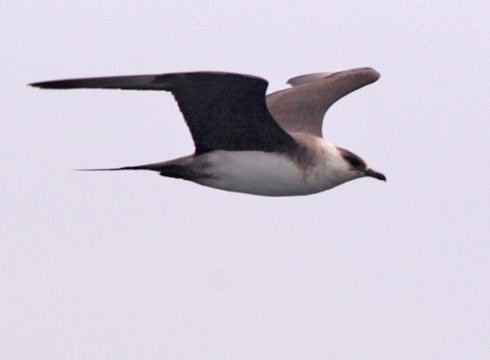
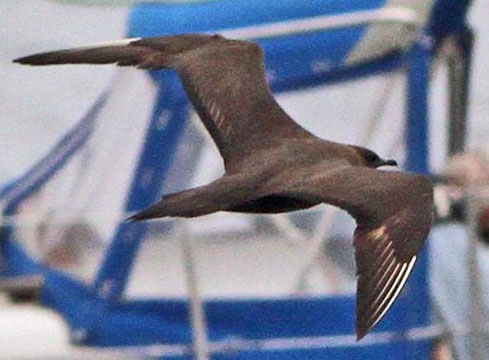
 All the photos so far have been of adults with characteristic tail patterns. Jaegers typically do not breed until 3 years old, and the larger skuas not until they are 5-6 years of age (Furness 1996, Olsen & Larsson 1997). Immature plumages are complex and the transitional forms in sub-adults are not well understood. Yet we do now have a good handle on the identification of juvenal-plumaged jaegers in their first flight south. The "cold-colored," short-billed juvenal jaeger in flight (right) is Long-tailed Jaeger. And yes, that is something different that the ocean in the background! This juvenal Long-tailed strayed inland to the Salinas wastewater ponds in September 1990.
All the photos so far have been of adults with characteristic tail patterns. Jaegers typically do not breed until 3 years old, and the larger skuas not until they are 5-6 years of age (Furness 1996, Olsen & Larsson 1997). Immature plumages are complex and the transitional forms in sub-adults are not well understood. Yet we do now have a good handle on the identification of juvenal-plumaged jaegers in their first flight south. The "cold-colored," short-billed juvenal jaeger in flight (right) is Long-tailed Jaeger. And yes, that is something different that the ocean in the background! This juvenal Long-tailed strayed inland to the Salinas wastewater ponds in September 1990.  The four species that Americans call skuas — the traditional 'Catharactca' species — are quite similar to each other, although one breeds in the high arctic [Great Skua, shown above in flight across the snow-bound, treeless island of Svalbard] and the other three breed on and around the South Polar ice-cap and sub-antarctic islands [e.g., Brown Skua, on territory on South Georgia Island in a nice shot by Greg Lasley, left).
The four species that Americans call skuas — the traditional 'Catharactca' species — are quite similar to each other, although one breeds in the high arctic [Great Skua, shown above in flight across the snow-bound, treeless island of Svalbard] and the other three breed on and around the South Polar ice-cap and sub-antarctic islands [e.g., Brown Skua, on territory on South Georgia Island in a nice shot by Greg Lasley, left). All the big brown skuas have prominent white patches at the base of the primaries. As noted, the big brown skua in northern Europe is Great Skua (right, a photo by John Marchant from Shetland), for which the Brits use the slang "bonxie." Great Skua, and the three similar species breeding around Antarctica, present an identification challenge; see Devillers (1977, 1978), Olsen & Larsson (1997). All four species of big brown skuas wander widely, although Brown Skua generally stays in southern oceans. Great Skua moves widely in the North Atlantic. Chilean Skua Stercorarius chilensis, often identifiable by the rusty-orange tones to the plumage (especially on the underwing coverts), moves up both coasts of South America, but does not wander to the northern Hemisphere (as far as we know). South Polar Skua is a trans-equatorial migrant in both the Atlantic and Pacific, with records as far north as the Gulf of Alaska.
All the big brown skuas have prominent white patches at the base of the primaries. As noted, the big brown skua in northern Europe is Great Skua (right, a photo by John Marchant from Shetland), for which the Brits use the slang "bonxie." Great Skua, and the three similar species breeding around Antarctica, present an identification challenge; see Devillers (1977, 1978), Olsen & Larsson (1997). All four species of big brown skuas wander widely, although Brown Skua generally stays in southern oceans. Great Skua moves widely in the North Atlantic. Chilean Skua Stercorarius chilensis, often identifiable by the rusty-orange tones to the plumage (especially on the underwing coverts), moves up both coasts of South America, but does not wander to the northern Hemisphere (as far as we know). South Polar Skua is a trans-equatorial migrant in both the Atlantic and Pacific, with records as far north as the Gulf of Alaska. 